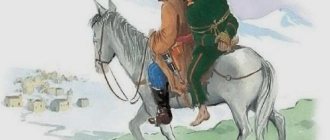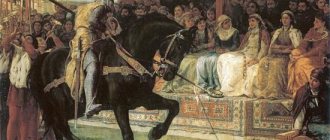About the product
The poem “Prisoner of the Caucasus” by Pushkin was written in 1821. The work is based on a romantic story about the passionate love of a hero disappointed in life for a beautiful Circassian woman. The scenery for it was the picturesque landscapes of the Caucasus and stories about the life of the mountaineers.
We recommend reading online a summary of “Prisoner of the Caucasus” chapter by chapter. A retelling of the work will be useful in preparing for a literature lesson.
The material was prepared jointly with a teacher of the highest category, Kuchmina Nadezhda Vladimirovna.
Experience as a teacher of Russian language and literature - 27 years.
Summary of A. S. Pushkin “Prisoner of the Caucasus”
The article presents a brief summary of the poem by A.S. Pushkin "Prisoner of the Caucasus". The work was written in 1820-1821 and became the first of his series of southern poems. Pushkin based the plot on the love story of a Russian young man who found himself in captivity for a beautiful Circassian woman. In addition to love lyrics, the author superbly described the beauty of the Caucasus, showed the life of the highlanders, and also touched on the topic of war.
Summary
Dedication
A. S. Pushkin dedicated his work to General N. N. Raevsky, the hero of the Patriotic War of 1812. It was to him that the poet owed his journey through the Caucasus, which deeply impressed him. Nikolai Nikolaevich was a faithful, devoted friend, in communication with whom Pushkin - “a victim of slander and vengeful ignoramuses” - “found peace” and “rested in his heart.”
Part 1
In one of the mountain villages the Circassians sat, talking “about abusive, disastrous anxieties, about the beauty of their horses, about the pleasures of wild bliss.” Suddenly a horseman appeared in front of them, dragging a Russian prisoner on a lasso. The whole village immediately came running to look at the “young prisoner,” who at first did not show any signs of life. When he woke up, he saw shackles on his feet. The young man immediately realized that from now on “he is a slave,” and it is unlikely that he will now end up in his native Russia, where he knew his first love and his first betrayal, where he left “memories of better days.”
The hero, fed up with the delights of secular life, went to the Caucasus to find true freedom. But instead of this heady feeling, he felt all the bitterness of captivity, and now he had only a few days left before death.
The prisoner was very surprised when a young Circassian woman sneaked up to him under the cover of darkness. It even seemed to him that “this is a false dream, an empty game of tired feelings.” The girl, taking pity on the exhausted captive, brought him kumiss. Gathering the rest of his strength, he raised the cup to his lips, but then, exhausted, fell to the ground. The beautiful Circassian woman sat next to him for a long time and cried with pity.
From now on, the girl began to visit the Russian prisoner every night to bring him food and wine. She began to teach him her language, and soon the morals and customs of the highlanders, their simple way of life, and concepts of honor were revealed to the captive. However, the prisoner was not touched by these pictures: he thought only about the upcoming end.
Part 2
A young Circassian woman, communicating with the captive, fell in love with him, knowing “the delights of the heart, the sweetness of life.” She confessed to the hero her love, and also that her father and brother “want to sell her to the evil one.” For the sake of feelings for him, she was even ready to die, choosing “dagger or poison” for this.
The prisoner listened to the Circassian woman’s confessions “with silent regret”: her passionate words evoked nothing in his soul except painful memories of his past life. He began to beg the girl to forget him, not to waste her beautiful, enchanting youth for his sake, and to love another, more worthy young man.
The prisoner regretted that he had not met the Circassian woman earlier, when his heart was free. But now the image of a girl unattainable for him lives in his soul. The Circassian woman burst into tears and began to reproach him for the fact that he could have taken pity and taken advantage of her naivety and inexperience. He would find solace in her love - pure, sincere, selfless. The girl wanted to know the name of his beloved, to which he replied that he had never “known mutual love, loved alone, suffered alone.” Now he doesn’t even want to think about love, since he is destined to die “far from the desired shores.”
One day the hero heard a noise and realized that the Circassians had begun preparations for the raid. Only children, women and old people remained in the village, but it was impossible to even think about escape: “the slave’s chain is heavy, the deep river is fast.”
When it got dark, a Circassian woman came to the prisoner with a saw and a dagger. She sawed through the shackles, gave him a dagger and assured him that no one would find him that night. The hero invited her with him, but the proud Circassian woman asked her to find her love in her homeland and forget about her suffering. He gratefully kissed the hand of his savior and went down to the raging river. Swimming to the other side, the prisoner heard a splash and a “distant groan”: the girl, unable to bear unrequited love, threw herself into the water.
The young man understood everything. Having looked around the village with a “farewell glance,” he went to the side where “Russian bayonets were flashing and the Cossack guards were calling out on the mounds.”
Epilogue
In the epilogue, the poet expressed his joy that “the ardent cry of war has fallen silent,” and from now on travelers can travel freely throughout the Caucasus.
Tomashevsky B.: Pushkin. Book One Chapter III. South. 4. “Prisoner of the Caucasus.” History of creation
4“Prisoner of the Caucasus” was conceived in the Caucasus, Pushkin worked on it in Gurzuf and then continued finishing it in Chisinau, Kamenka and Kyiv. The white text of the poem is marked “February 23, 1821 Kamenka
" After this, an epilogue was written, dated “Odessa 1821 May 15.” Thus, Pushkin spent about six months creating the poem (from the end of August 1820 to the end of February 1821). In September 1821, Pushkin invited N.I. Grech to publish a new poem. But N.I. Gnedich laid claim to it, to whom Pushkin sent the white manuscript at the end of April 1822. Having suffered great damage from censorship, the poem was published at the end of August. They've been waiting for her for a long time. The publication of this poem was greeted without the controversy that arose after the publication of “Ruslan and Lyudmila”. Readers and critics recognized the merits of Pushkin’s new work, and after that no one challenged his first place among Russian poets.
The original concept of the poem can be judged by its rough beginning, preserved in Pushkin’s notebook. In this draft the poem was called "Caucasus". Apparently, the poem acquired its final title in the last days of work on it.
The draft begins with an episode of the hero's capture. The first passage characterizes the mountaineers:
Alone, in the wilderness of the Caucasus Mountains, Covered with a combat cloak, the Circassian above the noisy river was hiding in the bushes...
Evening comes:
And suddenly the desert's dead sleep was interrupted... the dust rose in clouds, Chu! Thunder of wheels! The Circassian is boiling, he’s already on horseback, he’s already flying...
This is followed by a description of the captivity itself:
Why, O unfortunate young man, are you rushing towards death? You cannot protect Your head with a vain burst of courage! A flying enemy has overtaken you. And the weak pet was drawn to the mountains by a mighty lasso...
What follows is a description of how the Circassian drags a captive behind him, a description included in a somewhat revised form in the final text of the poem, in that part of the first song where the hero observes the morals of the mountaineers. In the final version, the picture of the abduction no longer has any relation to the hero’s own fate.
By excluding the story of the hero’s captivity from the final text of the poem, Pushkin did not change the very essence of the narrative in any way, and this scene in the original text is completely consistent with the final text. From it we learn who the hero was in Pushkin’s view. The prisoner was captured by the Circassian not in battle, but during the journey. He is not an officer, but a traveler,27 “a weak pet neg.” However, we find an indication of this in the final text, in verse:
A renegade of the world, a friend of nature, He left his native land and flew to a distant land With a cheerful ghost of freedom.
This is significant because Pushkin clearly wanted to give the hero his own characteristics. Pushkin applied escape from the light to a “distant land” to himself in the elegy “The Sun of Day Has Gone Out”:
I ran from you, fatherly land...
The same similarity in the depiction of the feelings of the hero and the author is noticed when comparing the “Dedication” with the text of the poem. The “dedication” to Raevsky is written in elegiac tones. Severely distorted in print by censorship, it contained the same motives for the “flights,” but with a significant strengthening of political motives and an indication of circumstances widely known to readers:
I dedicated the singing of the exiled lyre to you... I learned grief early, I was faced with persecution; I am a victim of slander and vengeful ignoramuses; But having strengthened my heart with freedom and patience, I waited carelessly for better days...
The same motif of freedom is present in the text of the poem, and the political meaning of this word is easily guessed by the reader. In the same way, the motive of persecution is present:
Don’t cry: I too am driven by fate...
The words about betrayal in the hearts of friends coincide with the verses of the “Dedication” (cf. “Friends of a minute of youth”) and that the prisoner was a victim
And bilingual hostility,
The same motives as in the elegy “The Sun of Day Has Gone Out” also contain the following verses:
A long path leads to Russia, To a country where He proudly began his fiery youth without worries, Where he knew the first joy, Where he loved many dear things, Where he embraced terrible suffering, Where with his stormy life he destroyed Hope, joy and desire, And memories of better days In the faded concluded the heart.
Close to the lyrical moods of Pushkin are the confessions of the Prisoner to the Cherkeshenka. So, it is impossible to deny Pushkin’s desire to instill the impression of identity of the spiritual appearance of the poet and the Prisoner. It is not for nothing that in a draft letter to N.I. Gnedich (April 29, 1822) he wrote about the “Prisoner of the Caucasus”: “... it contains poems of my heart.” The same is clearly stated in the “Dedication”:
Here you will find memories, perhaps days dear to the heart, contradictory passions, familiar dreams, familiar suffering, and the secret voice of my soul.
“Contradictions of passions” constitute the central node of the spiritual conflict of the hero of the poem. Plot-wise, this was expressed in the love drama of the Prisoner. This was the same image of the poet in the elegy “The Sun of Day Has Gone Out.” P. A. Vyazemsky wrote to A. I. Turgenev regarding this elegy (November 27, 1820): “I am sorry that this elegy is about love alone. Why not mention other heart failures? There was a place to have fun.”28 However, in this case, Vyazemsky did not fully guess the role of love in Pushkin’s plan. Love is for him the typical and poetic embodiment of passion in general. The test of passions was transformed into a romantic plot. Pushkin does not remain silent “about other failures of the heart,” but for the development of action, for the clash of characters, as well as for personal lyrical outpouring, poetry suggested to Pushkin precisely the theme of love. This did not interfere with artistic generalization, and for the reader neither the poet in the elegy “The Daylight Has Gone Out” nor the Captive in the poem seemed like traditional images of the “unhappy lover.” Behind the romantic background, other “failures of the heart” were felt and easily guessed.
In the old Pushkin literature, when interpreting “Prisoner of the Caucasus,” they looked for either a biographical basis or plot borrowing. Thus, P.I. Bartenev reported that the plot of the poem is based on the story of a certain Nemtsov, a distant relative and Moscow acquaintance of Pushkin. This Nemtsov, “who loved to invent extraordinary jokes about himself,” allegedly “once told under Pushkin that, while living in the Caucasus, he was captured by the mountaineers and was freed by a Circassian woman who fell in love with him.”29 for a similar plot, they began to look for another source. So, an indication was made of Chateaubriand. For a long time, this instruction enjoyed success, although it was based on a combination of plots from various works by Chateaubriand, one of which, although written earlier than Pushkin’s poem, appeared much later. Finally, the story of Xavier de Maistre “Prisoners of the Caucasus” was indicated. However, a simple superficial acquaintance with this popular story should, without any additional analysis, convince that the story and the poem have nothing in common with each other.30 All attempts to reduce the poem to one source or another turned out to be naive. However, it would be naive if we accepted Pushkin’s poem as a simple psychological self-portrait and completely identified the poet himself with his hero.
We have already seen that in “Ruslan and Lyudmila” the image of the narrator given in the poem itself diverged from the image of the poet reflected in the epilogue. We see exactly the same thing in “Prisoner of the Caucasus.” Neither the subject of the epilogue nor its tone coincide with the lyrical image imprinted in the poem itself. Therefore, the reader has the right to ask the question: where to look for the true image of the poet?
This question is partly answered by the interpretation of the author’s intentions that Pushkin gives in a letter to V.P. Gorchakov (October - November 1822): “The Captive’s character is unsuccessful; This proves that I am not fit to be the hero of a romantic poem. In it I wanted to portray this indifference to life and its pleasures, this premature old age of the soul, which became the hallmarks of the youth of the 19th century.”
- the embodiment of features distinctive for the youth of the 20s. This is a collective character, or rather, a generalized one. But the lyrical system of the romantic poem required a self-portrait image. A generalized image of a contemporary was given on the basis of introspection. The features that were common to the generation came into view.
Confessing the failure of the hero's character, Pushkin explained it by the fact that he himself was not suitable for romantic heroes. This is a very significant recognition of the contradiction that arose during the creation of the first major romantic work. Pushkin felt that he was not at all what would be required for an intended romantic poem. Pushkin forcibly transferred to himself the features of a hero of modern youth. What was appropriate for a lyric poem reflecting a temporary mood was not suitable for creating a character, where the psychological traits of the hero had to be given as the organic foundations of his behavior.
This contradiction, which arose during Pushkin’s very first steps along the path of romantic poetry, soon had its effect. The romantic period in Pushkin's work was not long. Two years after finishing Prisoner of the Caucasus, he began creating Eugene Onegin.
The generalized character of the Captive is not realistic according to the artistic system. Realistic generalization is associated with typification, that is, with the enrichment of character with details, with the development of its individuality and vitality. A typical image is a reflection of the general in the particular. In Pushkin, we see the opposite in his poem: the liberation of the hero from all traits that would go beyond the general. He himself writes about this in a draft letter to N.I. Gnedich (April 29, 1822): “The character of the main person (and there are only two of them) is more fitting for a novel than a poem - and what kind of character is this? who will be interested in the image of a young man who has lost the sensitivity of his heart in some misfortunes unknown to the reader.” Pushkin deliberately simplifies the story, avoiding any details and extraneous episodes: “... it would be easy to enliven the story with incidents that flowed naturally from the objects.” Pushkin refused all this. Hence a certain abstractness, schematic character, reminiscent of the works of classicism.
“Those who scolded me for not naming my Finn, did not find a single proper name
“Of course, they will consider this as unforgivable insolence.”
In the poem, the hero is referred to mainly as “prisoner”, sometimes “Russian”, once “European”. And the Cherkeshenka addresses him, calling him “Russian” or in isolated cases “prisoner” and “slave”. Here there is no need to talk about realistic psychology in the depiction of heroes. In the same way, the heroine is called “Circassian” or, more often, simply “maiden” (usually accompanied by some epithet: young, young, poor, or in combination “maiden of the mountains”).
The general sketchiness of the poem also explains the absence of other participants in the action, which Pushkin wrote about in the same draft letter to Gnedich: “The Circassian who captivated my Russian could have been the lover of my hero’s young deliverer. Her mother, father and brother could each have their own role, their own character - I neglected all this.”
"Poltava". In 1830 he wrote: “ Caucasian Prisoner -
the first unsuccessful experience of a character with which I forcibly came to terms” (“Rebuttal to Critics”).
However, even earlier he severely condemned the character of the Captive he created. However, it was precisely as the first
experience of a modern nature that the Prisoner found a response among young people, who were not as strict as the demanding artist himself. More than one reader compared himself to the Captive and dreamed of similar adventures. The very unusualness of the adventure captivated the imagination of young people who were looking for danger and exploits.
“The simplicity of the plan comes close to the poverty of the inventor,” Pushkin wrote to Gnedich. This simplicity matches the schematic nature of the poem. Given one position, one conflict. The hero is depicted as a “friend of nature.” The embodiment of untouched virgin nature is the Circassian woman, who combines the feminine traits of sincerity, naive spontaneity, and selflessness. The hero went through the test of passions and was poisoned by European civilization. The prisoner hides a “rebellious heat” within himself. The Circassian woman, before whom the world of passions opens for the first time, knows only open infant love:
For the first time with a virgin soul She loved, knew happiness...
"tender and submissive."
The image of the Circassian woman is perhaps even more abstract than the character of the Prisoner. The poet does not give a direct description of his heroine, turning mainly to indirect characteristics. Her appearance is accompanied by elegiac poems imbued with a feeling of sadness and pity. This tone is set by the first lines announcing her appearance:
In the midst of deep silence Walking, walking furtively?
The dialogues in the poem are, in fact, monologues. Each of the two characters speaks for himself and about himself. These are emotional outpourings, and criticism severely condemned Pushkin for his inappropriate frankness and offensive confessions of the Prisoner. But essentially the hero’s speeches are elegies that can be easily separated from the poem and turned into independent poems. Thus, the elegy “I survived my desires” in the white autograph has the subtitle “From the poem: Caucasus”, it was written in the spirit of the Prisoner’s complaints. Pushkin, apparently, was going to introduce this elegy into the Prisoner’s speech in the second song, after the verses:
Without rapture, without desires
The poem also has a theme that is equivalent to the plot action and complements it. The conflict of the poem lies in the contradiction between the withering passions of European civilization and untouched primitive nature. This conflict lies in the soul of the hero himself. On the one hand, he is a “victim of passions,” on the other, a “friend of nature.” The theme of nature was only partially embodied in the depiction of Cherkeshenka. In the poem, she finds a place in descriptions of the Caucasus Mountains and Circassian life.
Pushkin especially valued the descriptive side of his poem. In the preface to the second edition of 1828, he wrote: “This story, condescendingly accepted by the public, owes its success to a faithful, albeit slightly marked, depiction of the Caucasus and mountain customs.” In notes from 1830, he says about “The Prisoner of the Caucasus”: “... it was received better than anything I wrote, thanks to some elegiac and descriptive verses” (“Rebuttal to Critics”). In “Travel to Arzrum” Pushkin tells how he found a list of “Caucasian Prisoner” in Lars and adds (I quote the draft, more complete text): “All this is young, much is not bad, but much is guessed. I myself don’t understand how I could so faithfully, albeit weakly, depict the morals and nature that I saw from afar.”
The fidelity of the description is a quality noted in the previously cited draft letter to Gnedich. There Pushkin says: "...". Here he points out the difference between his descriptions and the romantic ones: “The local colors are correct, but will readers, spoiled by the poetic panoramas of Byron and Walter Scott, like it” (Pushkin, apparently, means the poetic works of Walter Scott).
In “Prisoner of the Caucasus,” Pushkin managed, perhaps for the first time, to achieve accurate descriptions, although they were given with a certain elegiac touch, like the observations of a hero. We find this manner of description in all southern poems, and only in “Eugene Onegin” does it undergo a significant change. In the descriptions of southern poems there is always a lyrical feeling of admiring the grandeur and unusualness of what is being described. Therefore, they are interrupted by exclamations (“Magnificent pictures!”), The choice of words emphasizes the grandeur of the landscape: “hulks,” “colossus,” “huge,” “majestic,” etc.
However, brief descriptions of times of day should be separated from such direct descriptions. For the most part, these are phenomena of the periphrastic style, characteristic of the “sublime” language in which the poem is written. Pushkin here does not say “in the morning”, “in the afternoon”, “in the evening”, but always resorts to descriptive allegory:
The sun is already fading behind the mountains; A noisy hum was heard in the distance... When will the horn of the silver moon flash behind the gloomy mountain... ......... There was deep darkness in the sky...
We find the same paraphrases in other places in the poem: for example, Pushkin will not simply say that the Circassian woman taught the Prisoner her language, but
And impatient memory conveys a foreign language...
In these periphrastic descriptions, if they do not develop into a more detailed picture, there is still a largely conventional literary element. This is the constant moon that accompanies the mysterious episodes of the poem.
Everything is dead... on the sleeping shores Only a light sound of the wind is heard, And under the moon in the splashing waters
Notes
27 This explains Pushkin’s typo, which was present in two white autographs and carried over into the first edition of the poem:
Live and be a traveler
In the draft manuscript, Chegodaev's autograph and later editions: captive
.
28 Ostafevsky archive of the Vyazemsky princes, vol. II. St. Petersburg, 1899, p. 107.
29 P.I. Pushkin in Southern Russia. M., 1914, p. 69. The author makes an even less probable assumption that Pushkin portrayed the actress Istomina, “a Circassian by birth.” But Istomina was not a Circassian. She performed the role of a Circassian woman in Didelot's ballet based on Pushkin's poem.
30 Zhirmunsky. Byron and Pushkin. L., 1924, pp. 40-43. Compare: A.I. On the question of literary sources of Pushkin’s “Prisoner of the Caucasus”. Collection of articles for the fortieth anniversary of the scientific activity of Academician A. S. Orlov, Ed. Academy of Sciences of the USSR, Leningrad, 1934, pp. 153-163.
Poem test
Check your memorization of the summary content with the test:
- /10
Question 1 of 10Who is the author of the work “Prisoner of the Caucasus”?
Start test
Hall of Fame
To get here, take the test.
- Natalia Vanichkina
5/10
- Elena Kapivas
10/10





